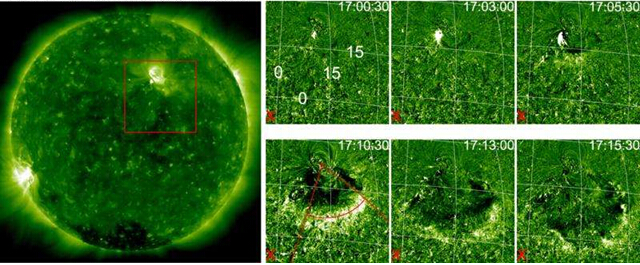http://www.sciencehuman.com 科学人 网站 2015-10-18

中国科技网10月15日报道(张微 编译)由美国洛克希德马丁公司先进技术中心的Nariaki Nitta和德国普朗克研究所太阳系统研究项目(MPS)的Radoslav Bucík领导的两组科研人员,各自独立地发现了一个新的太阳现象:恒星大气层中的大尺度爆炸波,这种爆炸波伴随着富含氦-3的高能粒子喷射。氦-3是惰性气体氦气的同位素气体。巨大的爆炸波有助于加速粒子向太空中的排放,MPS项目科学家们已经将这份报告发表在了《天体物理学》期刊上。这个决定性的发现要归功于两艘太空船STEREO A和 ACE,它们帮助科学家同时从两个不同的方向上观测太阳。而在不就以后,这种难得的观测机会就不会出现了。
太阳是一个高爆发的恒星:在剧烈爆发期,它一次次地向太空中喷射高能粒子和射线。其中的一个例子就是日冕物质抛射(CME),抛射出来的物质主要是电子和质子组成的等离子,还有少量的重元素,以及在短时间内释放出大量能量的X射线耀斑。这两种现象都与太阳爆发有关。两组研究人员利用观测数据,各自独立地发现了一个全新的太阳喷射方式:太阳大气层中的大型爆炸波,并伴随富含氦-3的高能粒子流。这个爆炸波可以通过观测强烈紫外线下的太阳大气层进行追踪。
2010年1月26日到2月2日的监测数据显示,爆炸波延伸了至少50万公里,并以大约每秒300公里的速度在传播。它们在一个弱的X射线爆发后马上发生,但是与典型的喷射状辐射有着显著的不同。没有发现日冕抛射物质触发了这个爆炸波的证据。“这个新现象就像是某种爆炸,”Bucik说,他领导了MPS项目研究,也是约翰霍普金斯大学,以及美国喷气推进实验室的专家。
爆炸波发生的同时,太阳向太空喷射富含氦-3的高能粒子流。太阳的这种粒子喷射已经为所大众熟知,但是其机理还没有得到充分的解释。“我们相信爆炸波加速氦-3排放,”MPS项目研究人员戴维娜 英尼斯说。“我们的分析已经查明典型的爆炸波性质,例如它们的能量,粒子性质的影响,”戴维娜的同事,也是MPS项目的研究人员Lijia Guo补充道。可是,这个爆炸波是如何发生的,尚不清楚。
为了观察爆炸波的现象和氦-3的物质抛射以及两者之间的联系,对于太阳的双重观测是非常必要的。由于太阳自转,喷射出的粒子离开恒星的轨迹是一个曲线弹射,有点像草坪上旋转的洒水器。因此,到达地球的粒子来自于太阳的右侧(从地球上观测)。而这个区域在地球上不能清楚地被观测到。
“STEREO A是太空中唯一的太阳观测平台,它并不靠近地球,只是围绕太阳运转,” Bucik解释道。在2010年初,太空飞船正好位于太阳右侧的上方。而当时,ACE的轨道接近地球,因此能够观测到粒子流,STEREO A记录了粒子流产生的区域——也就是EUV爆炸波。
研究人员认为,这种新现象并不罕见,但迄今为止还没有得到很好的观测。”不幸的是,在可预见的将来,这种观测将不再有机会发生”, bucik说。
STEREO A是美国宇航局2006年发射的两个探测器中的一个。这个探测器,称为A和B,围绕着太阳反方向运转,使我们能够从三维角度观测这颗恒星。由于去年十月份,STEREO B的通信中断,STEREO A只能继续独立地开展工作。到2025年它才会再一次到达和2010年一样的理想观测位置。ACE(要素/同位素成分高级探测器)是美国宇航局的太空船。从1997年以来,它一直在地球附近的一个观测点研究太阳、宇宙和星际粒子。
Blast waves in the sun's atmosphere
Two teams of researchers led by Nariaki Nitta from the Lockheed Martin Advanced Technology Center in the USA and by Radoslav Bucík from the Max Planck Institute for Solar System Research (MPS) in Germany have independently discovered a new solar phenomenon: large-scale waves in the star's atmosphere accompanied by energetic particle emissions rich in helium-3. Helium-3 is a light variety of the inert gas helium. The huge waves may contribute significantly to accelerate the particles into space, the MPS scientists now report in the Astrophysical Journal. Decisive for this discovery were the two spacecraft STEREO A and ACE making it possible to simultaneously observe the sun from two different directions. In the near future, no such opportunity will arise again.
The sun is a highly eruptive star: Again and again it emits energetic particles and radiation into space in violent outbursts. Examples of outbursts are the coronal mass ejections (CMEs) where a plasma of electrons, protons, and a few heavy atoms is hurled into space, as well as short, collimated X-ray flares. Both phenomena occur in connection with so-called solar eruptions. Two research groups have now independently discovered a completely new type of solar ejection in observational data: large wave fronts in the sun's atmosphere together with particle flows rich in helium-3. The waves could be tracked down by looking at the sun's atmosphere in extreme ultraviolet light.
The waves detected in data from 26 January and 2 February 2010 extended over at least half a million kilometers and propagated at a speed of approximately 300 kilometers per second. They occurred shortly after a weak X-ray flash, but differ significantly from this typical jet-like form of radiation. Coronal mass ejections as a trigger of the waves were not observed. "The new phenomenon is like a kind of explosion," said Bucik, who headed the team of researchers at the MPS, the Johns Hopkins University, and the Jet Propulsion Laboratory in the US.
Simultaneously with the blast waves, the sun hurls a particle stream rich in helium-3 into space. Particle emissions of this kind have been well-known for years, but could never be fully explained. "We believe that the blast waves accelerate the helium-3", says Davina Innes from the MPS. "Our analysis shows that typical characteristics of the waves, such as their energy, influence the properties of the particles", adds her colleague Lijia Guo, also stationed at the MPS. However, how exactly this works, is still unclear.
In order to observe both the wave phenomenon and the helium-3 ejections and so to recognize the connection between the two, a two-fold look at the sun was necessary. Since the sun rotates, ejected particles leaving the star travel on a curved trajectory similar to the water jets of a rotating lawn sprinkler. The particles reaching Earth have, therefore, originated on the right side of the sun (as seen from Earth). This region is not clearly visible from Earth.
"STEREO A is the only solar observatory in space, which does not remain close to Earth, but travels around the sun," explains Bucik. In early 2010, the spacecraft was located exactly above the right limb of the sun. While ACE orbiting close to Earth could detect the particle streams, STEREO A yielded recordings of the region where they originated – and thus of the EUV blast wave.
The researchers believe that the new phenomenon is not rare, but could so far not be well observed. "Unfortunately, however, in the foreseeable future the necessary viewing geometry will not occur again", says Bucik.
STEREO A is one of NASA'S twin space probes launched in 2006. The probes, called A and B, circle the sun in opposite directions thus allowing for a three-dimensional look at our star. Since the loss of communication with STEREO B last October, STEREO A has continued its observations alone. In 2025 it will reach the same favorable viewing position again as it had 2010. ACE (Advanced Composition Explorer) is a NASA spacecraft. Since 1997 it has been studying solar, cosmic, and interstellar particles from an observation site near Earth.
[中科网]
相关链接
十分震惊:太阳系边缘发现神秘物质层 证实中国学者预言(图)